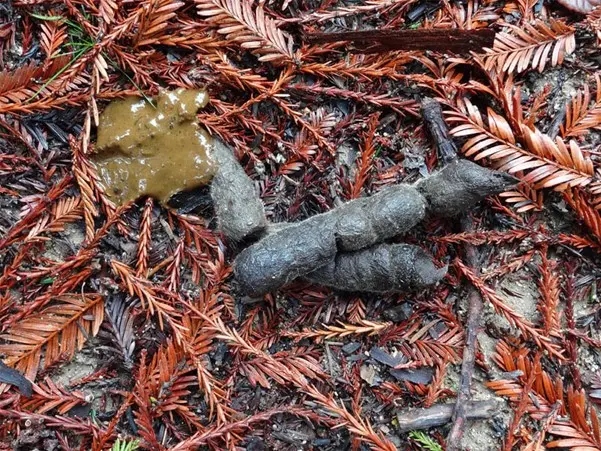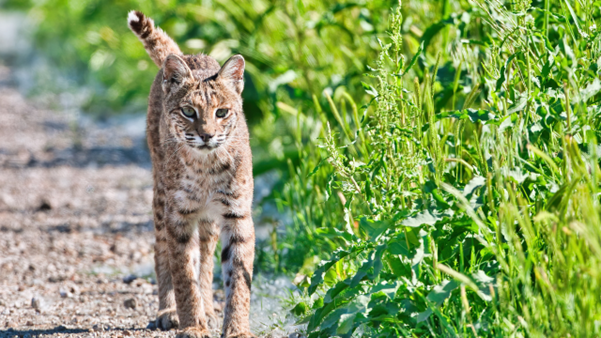Hiking offers an incomparable opportunity to immerse oneself in the tranquility of nature, often bringing us face-to-face with wildlife, such as the elusive bobcat. These encounters add an element of thrill and wonder to our outdoor adventures. However, they also underscore the importance of preparedness and knowledge, particularly when our path crosses with a bobcat. This majestic yet potentially dangerous creature commands respect and caution. Many hikers might feel apprehensive about such encounters, and rightfully so. This article aims at finding out what to do if you cross path with a bobcat by providing you with crucial information and practical guidelines should you ever find yourself sharing a trail with a bobcat.
What To Do If You Cross Path With A Bobcat:
Understanding Bobcats and Their Behavior:
Bobcats, scientifically known as Lynx rufus, are medium-sized felines, roughly twice the size of a domestic cat. They sport a distinctive rugged appearance, with a strong, compact body and a coat of short, dense fur that can range from grey to brown, often spotted or streaked with darker patterns. A notable characteristic that sets them apart is their pointed, tufted ears and short, ‘bobbed’ tail, from which they derive their name.
Predominantly solitary creatures, bobcats are highly territorial, marking and defending their zones vigilantly. Their habitat is diverse, spanning across forests, deserts, and swamplands across North America. Regarding their behavior, these felines are largely crepuscular, meaning they are most active during twilight, at dawn and dusk. Their hunting pattern mirrors this activity rhythm, stalking and ambushing their prey with great stealth and agility.
Despite their powerful hunting prowess, bobcats typically exhibit an elusive nature. They are naturally inclined to avoid human contact, often slipping away unnoticed when they sense human presence. This is largely a protective measure as bobcats, like many wildlife species, view humans as potential threats. So, while an encounter with a bobcat while hiking can undoubtedly be a thrilling experience, it’s important to remember that such instances are rare and often harmless if handled with respect and caution.
Preparing for A Safe Hike: Essential Tips:
Research the Wildlife
Before you set foot on any trail, it’s crucial to research the wildlife in the area you plan to hike. This should include understanding the behavior and activity patterns of animals like bobcats and the likelihood of encountering them. Knowledge of the local wildlife equips you with the ability to interpret signs of their presence and understand how they might react to human interaction. This measure not only enriches your hiking experience but significantly reduces the risk of surprise encounters and potential threats.
Pack Essential Safety Gear
Your safety is paramount on any hike. Therefore, packing the right gear is of utmost importance. This includes:
- Bear bells: Also known as wildlife bells, they can alert wildlife, such as bobcats, of your presence. Their sound helps prevent surprise encounters by warning animals to move away.
- Bear spray: If available and appropriate for your location, bear spray can provide an extra layer of protection. It’s designed to deter aggressive or charging wildlife, although its use should be a last resort.
- A hiking companion: There’s safety in numbers. Having a hiking companion enhances your hiking experience and adds an extra measure of safety should you encounter wildlife.
Dress Appropriately for Safety
Lastly, it’s essential to dress appropriately for your hike. This includes wearing sturdy, comfortable footwear that can handle the terrain and help you maintain your balance if you suddenly encounter wildlife. Bright clothing can also help deter wildlife by making you more noticeable. Additionally, long sleeves and trousers can protect from thorns, insects, and other minor hazards on the trail.
Following these guidelines will enhance your safety and enjoyment as you embrace the beauty and thrill of hiking in bobcat territory.

Hiking Techniques to Minimize Encounters:
Making Noise to Alert Wildlife
One effective hiking technique to minimize encounters with wildlife, including bobcats, is to make noise as you travel. The sounds you create, whether by talking, singing, or using wildlife bells serve as an early warning system for animals. Many animals, bobcats included, prefer to avoid human interaction if possible. The noise you generate announces your presence and gives them ample time to move away, decreasing the likelihood of a surprise encounter. This tactic can significantly enhance your safety on trails where bobcat sightings are common.
Travelling in Groups
Travelling in groups is another notable technique that can deter wildlife encounters. A group’s collective noise and size can create an imposing presence that deters many wild animals, including bobcats, from approaching. This joint hiking approach not only enriches your experience through shared memories but also adds a layer of safety to your outdoor adventures.
Staying On Designated Trails
Lastly, it’s crucial to stay on designated trails while hiking. Trails are mapped out carefully to minimize the disturbance to wildlife habitats and to maximize safety for hikers. Wandering off these paths increases the risk of inadvertently intruding into a bobcat’s territory, which can provoke defensive behaviors. By respecting the boundaries set by these trails, you maintain a safe distance from potential bobcat habitats and reduce your chances of an encounter. Following these hiking techniques can significantly enhance your safety and enjoyment while hiking in bobcat territory.
Recognizing Bobcat Signs:
1) Bobcat Tracks

Their tracks are among the most common signs of a bobcat’s presence. Bobcat tracks are unique and are often mistaken for those of a small dog or a large, domesticated cat. However, they distinctly differ in shape and the absence of nail marks. Their footprints are round, with four toe prints encircling a central pad print. The size of their tracks can range from 1 to 3 inches in diameter.
2) Bobcat Scat

Identifying bobcat scat, or feces, can also hint at their presence. Their scat is often tubular and segmented, typically 2 to 3 inches in length. It commonly contains fur or feather remains from their prey, reflecting their carnivorous diet. Keep in mind you should never touch or closely examine scat with the naked eye as it can contain harmful parasites.
3) Scratches on Trees
Bobcats, like many wild felines, have a habit of scratching trees, both as a means to mark territory and to sharpen their claws. Look out for vertical scratch marks on tree trunks or fallen logs. Unlike domestic cats, bobcats have the strength to leave deep gouges, often on larger trees.
4) The Value of Observation
Being observant while hiking is invaluable. It allows you to engage with your surroundings, learn from the environment, and increase your chances of spotting wildlife signs. Recognizing these signs of a bobcat’s presence can add an exciting element to your hike and enhance your understanding and appreciation of these elusive creatures. Always remember, the goal is to observe, not to interfere with these wild animals in their natural habitat.
Bobcat Body Language and Communication:
Understanding Bobcat Body Language
Bobcats, like other wild animals, communicate largely through body language. Understanding these non-verbal cues can offer valuable insights into a bobcat’s mood and intentions. A relaxed bobcat generally has its ears in a neutral or forward position, its tail down, and its body posture relaxed. By contrast, a bobcat that feels threatened will demonstrate defensive body language, such as flattened ears, widened eyes, arched back, and a puffed-up tail. These are clear indicators that the animal feels threatened and prepares for a possible confrontation.
Interpreting Vocalizations
In terms of vocalizations, bobcats are generally quiet creatures. However, they may resort to various sounds to express their discomfort when threatened or uncomfortable. Hissing, growling, and spitting are common warning signs that a bobcat feels threatened and wants to keep you at a distance. These sounds are generally accompanied by aggressive body language, such as bared teeth and a defensive stance, signaling that the bobcat is prepared to defend itself if needed.
What These Cues Mean for Hikers
For hikers, these cues serve as an important warning system. If you encounter a bobcat displaying such signs, it’s crucial to respect its space and back away slowly, avoiding direct eye contact, which can be perceived as a threat. Remember, the bobcat is likely more afraid of you than you are of it. Its aggressive behavior is simply a defensive strategy to protect itself. It’s important to remember that bobcats are wild animals and unpredictable by nature. Therefore, maintaining a safe distance is always the safest approach, even if they don’t initially show signs of aggression.
Responding Appropriately
Upon spotting a bobcat, your first reaction should be to give it ample space. If it shows signs of aggression, do not attempt to scare it off or approach it. Instead, make yourself appear larger by standing tall and opening your jacket if you have one. Speak in a firm, calm voice while backing away slowly and avoid running, as this could trigger a chase response. If the bobcat continues to approach, make loud noises to scare it away. As a last resort, should the bobcat attack, protect yourself using your hiking gear, such as hiking poles or even a bear spray, if you’re carrying one. Always prioritize your safety above all else when encountering wildlife, including bobcats.

Encountering a Bobcat: Do’s and Don’ts:
If You Spot a Bobcat from a Distance
If you spot a bobcat from a distance, maintaining a safe distance is the first rule of thumb. Avoid sudden actions or loud noises that might startle or provoke the bobcat. Use this unique opportunity to observe the bobcat’s behaviors and habits from afar but refrain from approaching the animal. Remember, the goal is to appreciate these elusive creatures in their natural setting without causing any interruption or distress.
If a Bobcat Approaches You
Should you find yourself in a situation where a bobcat approaches you, it’s crucial to stand your ground. Create the illusion of being larger by raising your arms and opening your jacket if you have one. It’s also beneficial to maintain eye contact as you slowly back away without turning your back to the bobcat. Most bobcats are naturally wary of humans and prefer to avoid confrontations. By providing an escape route, the bobcat might choose to leave on its own accord.
If a Bobcat Acts Aggressively
In the unlikely circumstance that a bobcat acts aggressively, your response should be to make yourself appear as large as possible. Speak in a firm but calm and assertive voice. If the bobcat continues to approach, consider throwing objects near it (not directly at it) to deter its advance. It’s vital not to run or scream, as this may activate the bobcat’s predatory instincts. Always remember that your safety is paramount; these are wild animals with unpredictable behaviors.
Reporting Bobcat Sightings:
Reporting to Local Wildlife Authorities
If you have sighted a bobcat during your hike, the first step you should take is to report the sighting to your local wildlife authorities or relevant organizations. This could be your state’s Department of Fish and Wildlife or a local wildlife conservation group. These organizations rely on public reports to track wildlife populations, understand their movements, and monitor their well-being. By providing accurate information about the bobcat’s location, time, and behavior, you are contributing to essential data collection efforts that assist in managing and protecting these creatures.
The Importance of Shared Knowledge
Reporting your bobcat sighting has a significant impact beyond the immediate moment. The data collected from public reports are invaluable for wildlife research and management strategies. It helps build a more accurate understanding of bobcat populations, their behaviors, and their challenges in their natural habitats. This information, in turn, influences policies and conservation efforts to protect and preserve these beautiful, elusive creatures.
Sharing Your Experience on Social Media
Finally, consider sharing your bobcat sighting on social media platforms, using dedicated hashtags like #BobcatSighting or #WildlifeEncounter. This allows you to share your unique experience with your community and contributes to raising awareness and promoting education about wildlife and their habitats. However, it’s crucial to share responsibly, ensuring that the exact location of the sighting is not disclosed to prevent disturbance by curious visitors. Always remember, our goal is to appreciate and protect these animals, not to interfere with their natural lives or to put ourselves and others in unnecessary danger.
Additional Resources
If you are looking for more tutorials, walkthroughs and troubleshooting about camping and enjoying the outdoors, here are some additional posts to check out:
In Conclusion
In summary, understanding the habits and behaviors of bobcats is vital for any hiker. Knowing their warning cues can help prevent unnecessary confrontations and ensure your safety. Proper hiking techniques, such as maintaining a safe distance and avoiding direct eye contact, can prevent encounters from escalating. Should an encounter occur, knowing the correct response is crucial: stand tall, make yourself appear larger, and back away slowly.
Above all, respecting wildlife and their habitats is important, recognizing that we are visitors in their homes. Share this knowledge with fellow hikers, promoting a culture of respect and harmony with nature. If we all do our part, we can ensure the preservation of these stunning creatures and the beautiful wild spaces they inhabit for generations to come. Thanks for reading, If you think I forgot something or if you simply want to share a story, feel free to leave your comment below. Be safe and happy hiking.!

